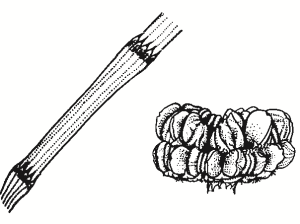Family:
Casuarinaceae
Allocasuarina luehmannii
Bulloak
(syn. Casuarina luehmannii)
Other Names: Buloke

Name Origin:
Allocasuarina — meaning different from Casuarina. Allocasuarinas are distinguished from Casuarinas by the cones.
luehmannii — after J.G. Luehmann (1843 – 1904), past Director of Melbourne Botanic Gardens.
Regional Subspecies:
Similar Species:
Distinguished from Drooping Sheoak (Allocasuarina verticillata) mainly by its cones, which are much shorter, and by its more upright habit.
Occurrence:
Regional:
West of Hume Highway. Noted in districts of Bowna-Jindera; Yambla; Yerong Creek-Wattle Creek, and drier country.
Australia:
Qld, NSW, Vic, SA.
Habitat:
Woodland on non-calcereous soil, often with White Cypress Pine (Callitris glaucophylla) and Grey Box (Eucalyptus microcarpa) and on plains, gently undulating slopes and in drier areas, around edges of swamps and depressions. More common on sandy soils.
Habit:
Tree 5-15 m high with rough, deeply fissured bark and ascending branches.
Site Preference:
Sandy clays. Tolerates brief seasonal inundation, and adapts to a wide range of heavy soils.
Tolerates drought, frost, strong wind and saline soil.
Characteristics:
Moderate growth rate. Long lived. Sensitive to fire. Nitrogen-fixing. Not prone to damage from insect activity. Dioecious (trees are male or female).
Flowering:
Yellowish (male flower spikes), Oct-Nov.
Seed Collection:
Mid-Dec to mid-May. Seeds shed annually in early autumn. Collect cones by hand or knock down with poles. Seeds rapidly lose viability unless stored in refrigerator, or sown fresh.
Propagation:
From untreated seed (84-119 viable seeds per gram), which should germinate in 2-5 weeks. Some growers recommend stratifying seeds in freezer for 2 weeks, and sowing in cooler months.
Regeneration:
Suckers from roots, and regenerates from cut stumps. Seeds germinate late summer – early autumn and early to mid spring, in warm wet conditions. Seedlings highly palatable to livestock and rabbits, and require protection for 5-7 years to establish. Permanent fencing recommended to ensure long-term health and regeneration of existing trees.
VALUES:
Shade & Shelter:
Useful medium-level cover in windbreaks. Provides partial shade. Fine foliage restricts summer sun and filters winter sun.
Land Protection:
Useful in land reclamation where suckering is an advantage. ‘Leaf’ litter stabilises soil surface.
Improves soil fertility through ‘fixing’ nitrogen.
Wildlife:
Excellent habitat. Seeds eaten by birds including parrots, cockatoos and finches. Valuable roost and nest sites for birds on plains country, including the Grey-crowned Babbler. Good foraging for the Apostlebird. Important for small insect-eating birds such as sittellas and thornbills.
Fuel:
Excellent. Burns quietly and generates strong heat.
Timber:
Dark red, very hard, strong and heavy. Moderately durable but unsuitable for in-ground use. Tends to split when nailed and does not season readily. Used for fencing and wood turning. Was used to make shingles, farm buildings and tool handles. Sawdust is irritating.
Ornamental:
Useful amenity species for parks and gardens.
Other:
Potential for planting for firewood under coppice regime, although slow-growing. Tolerates lopping, hence smaller branches of crown can be cut for drought fodder (palatable, but very low-value feed).
